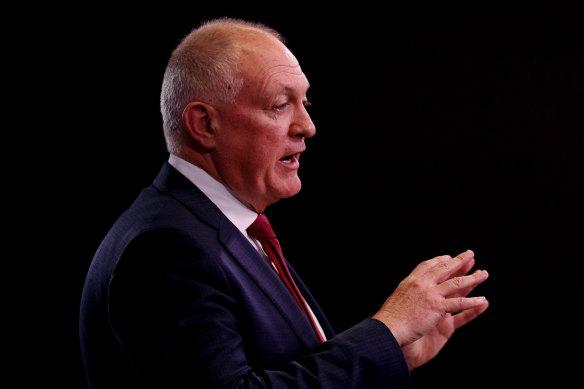- Graphic content
- National
- NSW
- Greyhound racing
The drugs that make dogs’ bones shatter
By Christopher Harris and Jordan Baker
WARNING: GRAPHIC CONTENT
Greyhounds are fed osteoporosis drugs illegally, which hardens their bones in a way that makes them more likely to break and shatter, while millions of dollars spent on trying to make racing tracks safer since 2017 have failed, a research paper by Greyhound Racing NSW’s former chief vet says.
The state government moved to head off mounting controversy over allegations of horrific animal cruelty within the greyhound racing industry by appointing Lea Drake to lead a review in her capacity as acting commissioner of the NSW Greyhound Welfare and Integrity Commission (GWIC).

Racing Minister David Harris announces the inquiry on Thursday.Credit: Nikki Short
NSW Racing Minister David Harris on Thursday announced that Drake, a Fair Work Commissioner with more than two decades’ experience, would examine the claims raised in an email written by outgoing chief veterinary officer Alexander Brittan and revealed by the Herald earlier this week.
The government has ruled out shutting down greyhound racing in NSW, as has been done in the ACT. Harris said the industry was capable of reform and said the inquiry’s focus would be making sure it employed best practices and had animal welfare as its main feature.

Former LECC commissioner Lea Drake.
“There is a number of initiatives they’ve put in place since that initial [2016] inquiry which has aimed to improve the industry. This is about ensuring that they stay focused and on task,” he said.
A source close to Greyhound Racing NSW, who spoke on the condition of anonymity because they did not have authorisation to speak publicly, said the board had organised its own independent inquiry after it received the Brittan report.
It had secured the services – through verbal agreement, although not yet formal contract – of Michael McHugh, the former high court judge who undertook the 2016 Special Commission of Inquiry for former premier Mike Baird, which found the sport was beyond remedy. The Herald contacted McHugh for comment.
The person said McHugh was a sensible choice to run an inquiry because he knew the industry well, and said it could proceed with the agreement of the minister.
The Herald asked Harris if he was aware that McHugh had been approached and if he supported him leading an inquiry. A spokesman said: “The minister is focused on matters announced today.”
Harris has asked the board of Greyhound Racing NSW to show cause why it should not be dissolved on the grounds it breached its operating licence, which says it must disclose anything that brings the industry into disrepute immediately. It has until 5pm on Friday to respond.
The email from Brittan also alleged rehoming rates were inflated, dogs raced at unhealthy intensity were suffering a massive rise in injuries and most were then left to “live out their miserable post-racing lives in industrial kennels”.
GRNSW’s outgoing chief executive received Brittan’s document on June 14, and Harris was given a copy four days later. However, the source said the industry regulator believed putting the industry into administration would not be in its best interests as it would stall efforts to improve animal welfare.
Other documents tabled in NSW parliament on Thursday included a document titled “Track Safety Research Update” written by Brittan for GRNSW.
Brittan said despite $30 million spent on research and changes to physical track design, injury rates had increased, and had jumped tenfold with the introduction of a $60 subsidy per dog per race in 2022.
“This travel subsidy has had in my opinion, the greatest negative effect on race injury rates of any policy to date. It needs to be stopped or heavily amended immediately,” he wrote.
He said that it meant trainers were racing dogs who had little chance of winning but wanted the money. Under NSW rules, dogs were allowed to race every two days which he labelled cruel and susceptible to injury.
“It is physiologically impossible for a greyhound to recover in this period and racing at this barbaric frequency will only lead to physiological fatigue,” he wrote.
He said there was anecdotal evidence that Tildren – a human drug used to treat osteoporosis– was being used off label and illegally by trainers who believed it toughened up dogs’ bones.
“There is enough anecdotal evidence that this drug is being used off label and illegally within the industry that Greyhound Australasia are in the process of implementing a new rule that will formally classify this drug as a banned substance,” he said.
“[Whilst] it makes bones harder, it also has the unfortunate sequelae of making bones more brittle and thus more likely to shatter when put under heavy forces.”
He also raised the project of research to find better sand to use on tracks to prevent injury but said major universities did not wish to engage on any research with Greyhound Racing NSW.
Greyhound Racing NSW did not directly respond to questions about recovery periods, osteoporosis drugs or track design on Thursday. In a statement, it said it had appointed former Victorian Police commissioner Graham Ashton to conduct its own independent review and it would be inappropriate to comment further.
In the first three months of this year, a total of 1046 dogs, or 11 a day, suffered an injury before or after a race in NSW. Of those, 108, or the equivalent of one a day either died, or suffered a long bone fracture, a severe spinal, pelvic or skull injury, a major fracture dislocation, or an Achilles tendon rupture.
The inquiry will cover greyhound welfare and the care of greyhounds by GRNSW, including adoption and rehoming programs; GRNSW processes and management, including procurement and recruitment practices; reporting and accuracy in relation to greyhounds; management’s response to complaints or concerns about organisational and workplace culture and conduct.
The terms of reference have not yet been determined. It is not yet known if the inquiry will be held in public, with those details to be determined by Drake once she is officially appointed to the role.
She is due to report back to the government on December 12.